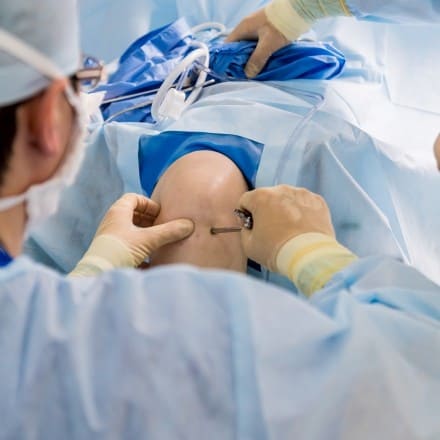

Arthroscopic Knee Surgery is a minimally invasive surgical procedure in which an arthroscope examines and sometimes treats a joint by directly visualizing the inside of the joint to a video monitor. The arthroscope allows the doctor to see inside your joint and repair damage, including removing loose or torn cartilage or repairing a torn meniscus.
The arthroscope is a small fiber-optic viewing instrument used to see inside a joint during an arthroscopy procedure. The surgical instruments used in this type of surgery are tiny but appear much larger when viewed through the arthroscope.
A TV camera attached to the arthroscope displays an image of the joint on the TV screen, allowing the surgeon to see under the patella and the entire cartilage and ligaments of the knee. The surgeon can decide the extent or type of damage and repair. This procedure is usually performed for patients under spinal anesthesia or general anesthesia.
Inflammation

Arthroscopy is a minimally invasive surgery that utilizes an arthroscope to evaluate and diagnose joint injury, disease, or damage. The joint is small, and incisions are made around the joint. Then, the scope is inserted into the body, and the scope’s lens provides the surgeon with magnified views of your joint. After an evaluation and any necessary corrective measures are taken, the scope is removed from the body, wounds are sutured or bandaged, and activity can continue as normal.
Arthroscopy is useful in diagnosing and treating many non-inflammatory, inflammatory, and infectious arthritis and various injuries within the joint. Common conditions in which Arthroscopy is used include shoulder, knee, elbow, and hip pain due to tears in the rotator cuff tendon, anterior cruciate ligament tears, meniscal injuries of the knee, and chondral insufficiency of the patella. In addition, Arthroscopy helps in the treatment of chronic shoulder pain.

Although rare, occasionally, complications do occur during or following Arthroscopy. Most of these are minor and may involve infection, swelling, bleeding, damage to blood vessels or nerves, or breakage of instruments. They occur in less than 1 percent of all arthroscopic procedures when they do occur.
Arthroscopic knee surgery reduces recovery time and overall discomfort. Doctors can evaluate your knee structures through the arthroscope, find structural damage and repair those specific structures. Knee joint repairs are generally easier with arthroscopic surgery.
There are several benefits to this kind of procedure, including Minimal incision (in some cases, the incision is about the size of a dime), Less pain after surgery for most patients, getting back on your feet faster. Most patients have their arthroscopic surgery as inpatients and are home several hours after the surgery.

After Arthroscopy, small incisions are made in your joint to help remove the damaged part of the joint. These puncture wounds take several days to heal, and the operative dressing can usually be removed in the morning after surgery. Adhesive strips can be used to cover the small healing incisions. Although most of the puncture wounds are minor and pain in the undergoing joint Arthroscopy is generally minimal, you will experience stiffness and loss of motion. In contrast, the contact between your skin and joint is limited.
Athletes and active individuals may be able to return to their activities sooner than they expect. However, with an experienced surgeon, a complete evaluation can define whether or not you’re a good candidate for the procedure and when healing will begin. In addition, people with Arthroscopy are unique in their diagnosis and preexisting conditions, so your recovery time will reflect that individuality.
After the procedure, steps are taken to give relief from discomfort. Patients will get tired immediately after surgery, mainly when general anesthesia or sedation is used. If necessary, medication is given to relieve the pain.
There may be numbness when using spinal or regional anesthesia and weakness of the extremity for a few hours to days that gradually resolves before the patient goes home (usually several hours after surgery).

Arthroscopic knee surgery is a surgical method that allows surgeons to view the inside of a joint through a small incision. The surgeon inserts instruments (arthroscope and other tools) that enable them to repair torn ligaments and cartilage and treat other conditions such as loose bodies, chondromalacia, and osteochondritis dissecans and osteoarthritis.
Knee arthroscopy is used to diagnose several knee problems, including a torn meniscus and a misaligned patella (kneecap). It also may be used to repair the damaged ligaments of your joint. There is a low risk of complications, and most people recover quickly.
Knee Arthroscopy surgery can diagnose and treat knee injuries, including:
We use cookies to enhance your experience. By clicking "Accept", you agree to our use of cookies.